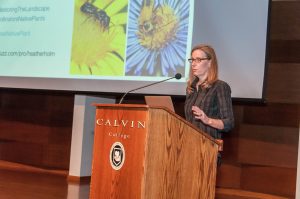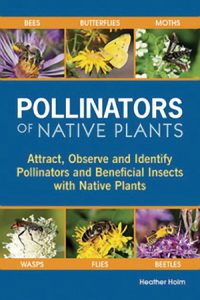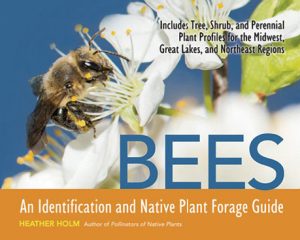The Buzz on Bees
A recap of Heather Holm’s presentation at River City Wild Ones 10th Anniversary Celebration September 18, 2017
By Nancy Bedell, RCWO Education Chair
 River City Wild Ones and Calvin College Eco-Preserve partnered to celebrate local Wild One’s chapter’s 10th anniversary with a special speaker on September 18, at Calvin’s Covenant Fine Arts Center Recital Hall. Heather Holm, horticulturist, biologist, researcher, writer and publisher from Minneapolis joined us for her presentation and book signing. Her new book, Bees: An Identification and Native Plant Forage Guide was on sale along with her previous work, Pollinators of Native Plants. Although she did not detail her research projects determining types of native bees present in cultivated blueberry farms in Minnesota and Wisconsin, we benefited from her research, which enhanced her depth of knowledge of bees and showed video and photos from her work.
River City Wild Ones and Calvin College Eco-Preserve partnered to celebrate local Wild One’s chapter’s 10th anniversary with a special speaker on September 18, at Calvin’s Covenant Fine Arts Center Recital Hall. Heather Holm, horticulturist, biologist, researcher, writer and publisher from Minneapolis joined us for her presentation and book signing. Her new book, Bees: An Identification and Native Plant Forage Guide was on sale along with her previous work, Pollinators of Native Plants. Although she did not detail her research projects determining types of native bees present in cultivated blueberry farms in Minnesota and Wisconsin, we benefited from her research, which enhanced her depth of knowledge of bees and showed video and photos from her work.

 Heather reminded us that native bees and beneficial insects not only pollinate our food, but provide other ecosystem services such as keeping insect populations in balance, helping recycle organic materials, and providing food for other insects, etc. She introduced several categories of non-bees: social wasps, solitary wasps, beetles, flies, and lace wigs. With over 4,200 species of bees in the US and Canada and over 20,000 worldwide, we are blessed in Michigan with around 500 native bee species. Native bees pollinate 80% of plants on earth, so it’s unimportant that they don’t produce honey like non-native honeybees. Most native bees are solitary and none are aggressive. Wasps have a bad name for being aggressive, but only the yellow jacket protects its nests. We need to overcome the human fear of bees and wasps and instead welcome them into our landscapes because they are in danger of continued population die-off due to use of wide-spectrum herbicide and continued habitat loss.
Heather reminded us that native bees and beneficial insects not only pollinate our food, but provide other ecosystem services such as keeping insect populations in balance, helping recycle organic materials, and providing food for other insects, etc. She introduced several categories of non-bees: social wasps, solitary wasps, beetles, flies, and lace wigs. With over 4,200 species of bees in the US and Canada and over 20,000 worldwide, we are blessed in Michigan with around 500 native bee species. Native bees pollinate 80% of plants on earth, so it’s unimportant that they don’t produce honey like non-native honeybees. Most native bees are solitary and none are aggressive. Wasps have a bad name for being aggressive, but only the yellow jacket protects its nests. We need to overcome the human fear of bees and wasps and instead welcome them into our landscapes because they are in danger of continued population die-off due to use of wide-spectrum herbicide and continued habitat loss.
Heather encouraged us to make places for these little-known native insect species so instrumental to a balanced landscape. Leaf litter is still the best mulch. Left undisturbed it can serve as wintering space for insect larvae. Plant stalks left at least 15″ tall serve insects for nesting in spring. Having a “messy” landscape with uncut dying stalks does not always attract neighborhood enthusiasm, so maybe do more of it in the backyard. 70% of bees nest in lawns, between rocks, usually in looser soils. Leave uncovered areas for bees to use for nesting. Heather reminded us that many beneficial insects are specialists, can collect pollen from one genus or species only. In planning a native garden one can take all of these many benefits into consideration. In their nectar, native plants provide four times the nutritional value of cultivars and aliens (plants not native to our landscapes), another important reason to plant natives. Heather encouraged us to plant clumps of one native plant species so that bees can have considerable forage opportunity in a small space. Smaller bees can range only a few hundred yards from their forage and thus need food sources close to their nests. Also, some seedlings such as ash seedlings should be left for leafcutter bee use.
As overall guidelines for native planting, try to have plants flowering through the entire season, to provide sustenance for bees and beneficial insects. Don’t overlook trees and shrubs as providers of many ecological services. In a woodland plant an understory of shrubs. And standing dead trees provide much food for many insects, in some cases more than live trees.
The specifics of the many beneficials Heather presented were fascinating since she had her own photos and videos of wasps, flies, beetles and lace wigs. Her photos of the leafcutter bees work in a plant stalk cylinder was breathtaking: 6 plant leaves whorled carefully inside a stem with a micro antibiotic injection from the bee introduced to protect the pupa over winter.
We thank Heather sincerely for inspiring us all to learn more and appreciate the web of life and its insect components, so we vow to protect and plant native plants to sustain their benefactors and co-dependants: native bees, wasps, flies, beetles, and lace wigs.
